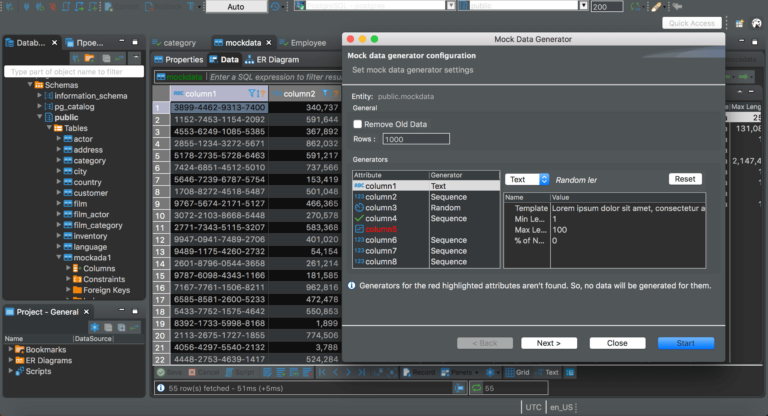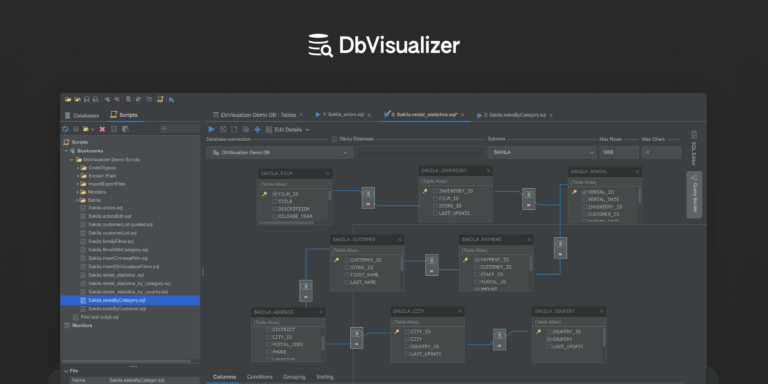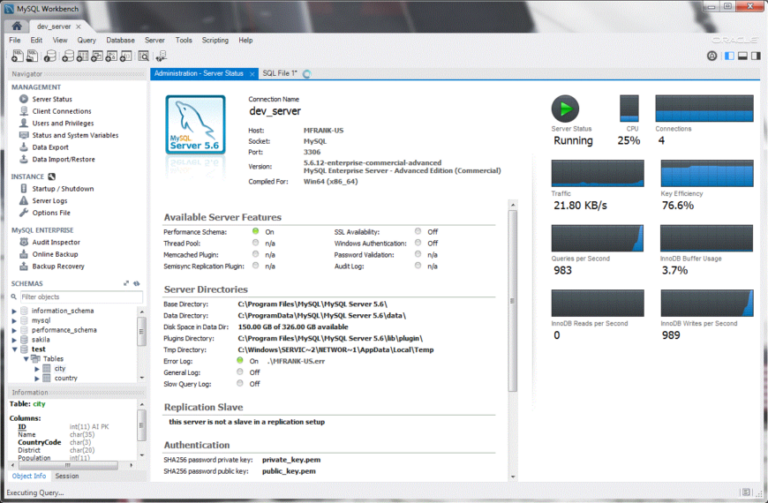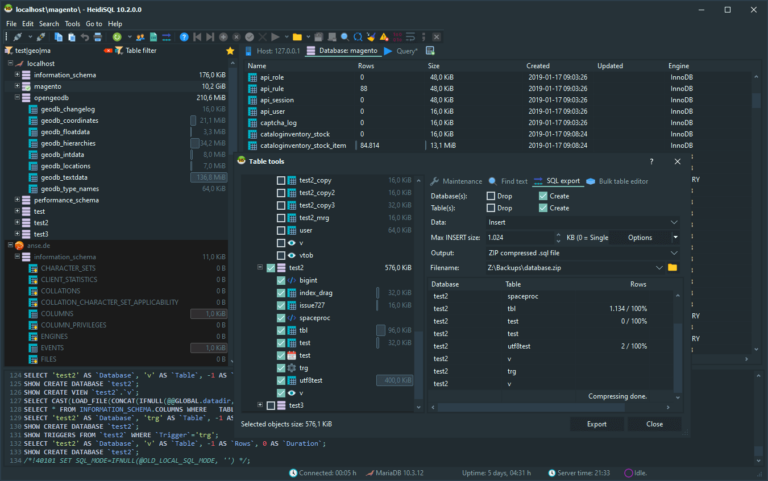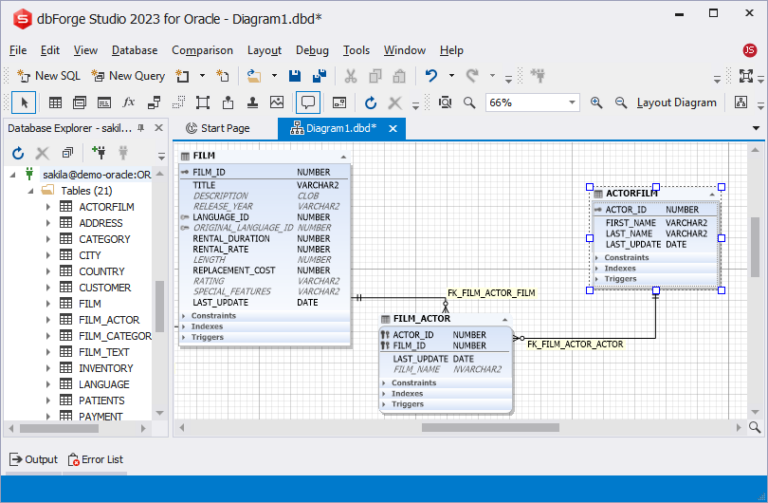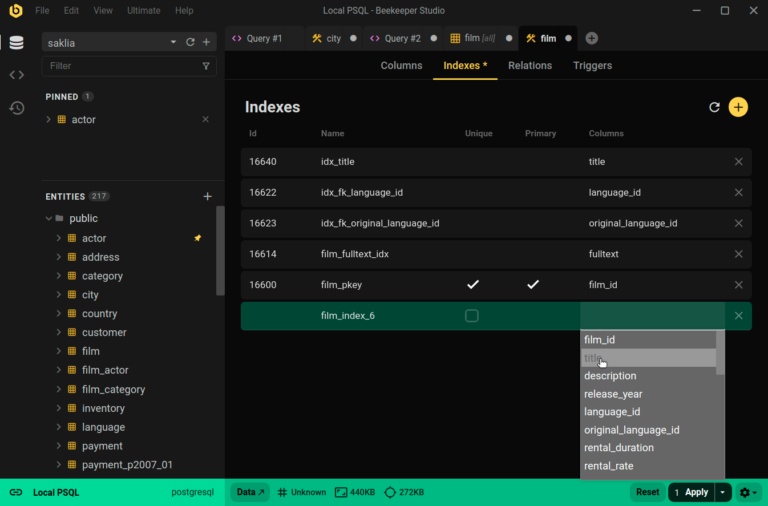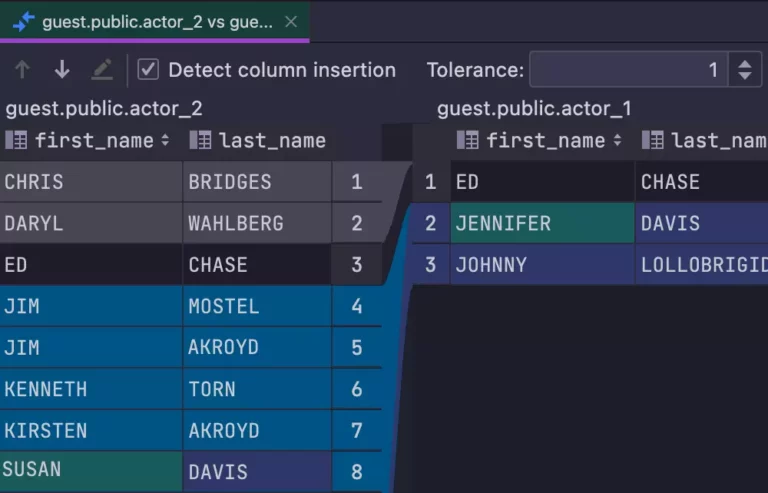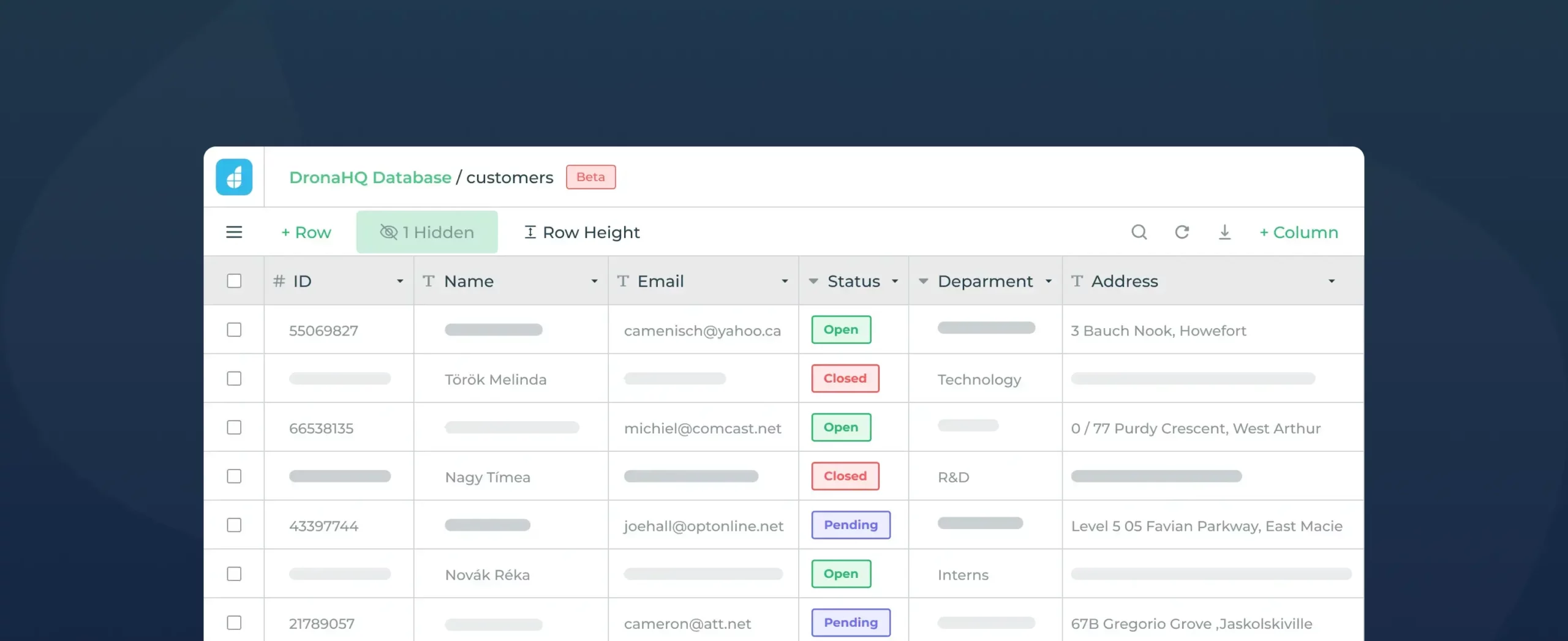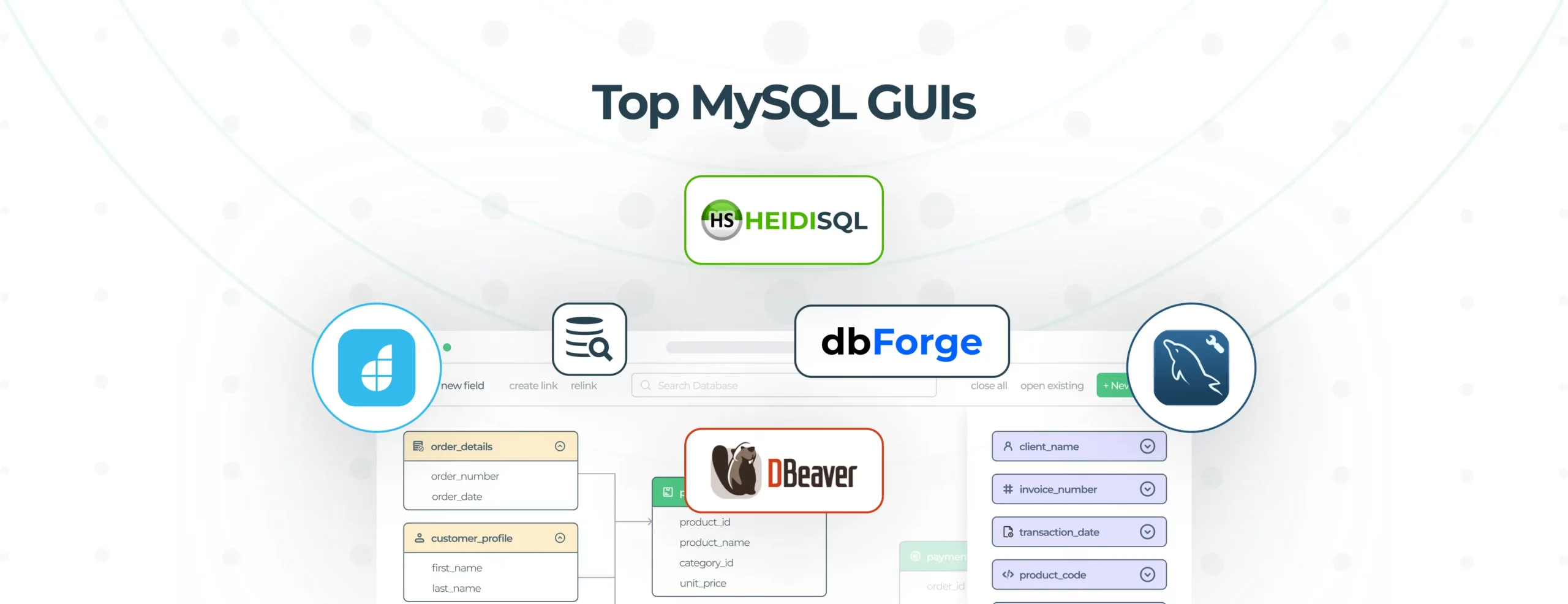

Top 9 MySQL GUIs to explore in 2024
Did you know that MySQL got its name after co-founder Monty Widenius’s daughter, My?
And the signature MySQL Dolphin (logo) has a name. “Sakila”. It was chosen from a huge list of names suggested by users on a MySQL run “Name the Dolphin” contest. There are more such tidbits on the History of MySQL here.
What is MySQL?
MySQL stands as a popular choice for websites and web applications, serving as the go-to database for backend storage. Its widespread adoption can be attributed to several key advantages:
- MySQL is a widely used relational database management system (RDBMS) renowned for its versatility.
- It’s both free and open-source, making it accessible to developers of all backgrounds.
- MySQL is suitable for projects of all sizes, from small-scale applications to large enterprise systems.
- It’s easy to find help for MySQL questions.
MySQL ranks first as the world’s most popular database in both StackOverflow’s Annual Developer Survey, as well as Kaggle’s Data Science & Machine Learning Survey 2021. This shows just how popular MySQL is as a database technology.
MySQL maintains its dominance in the database landscape due to a combination of factors. Its open-source nature fosters a strong community of developers who contribute to its continual improvement and support. MySQL also boasts a long history of reliability and performance, making it a trusted choice for diverse applications. Its compatibility with various platforms and programming languages enhances its appeal, while continual evolution and integration with other technologies ensure its relevance amidst emerging competitors.
With an SQL database comes manual queries
People query MySQL data using SQL (Structured Query Language), which is a standard language for interacting with relational databases like MySQL. SQL allows users to retrieve, manipulate, and manage data stored in MySQL databases. They use SELECT to retrieve specific columns, aggregate functions for calculations, join to combine data, sorting and limit results, and WHERE for filtering.
But, depending solely on manual queries can be daunting for newcomers, given the need for precise syntax and a thorough grasp of database structures.
This is where Graphical User Interfaces (GUIs) prove invaluable, streamlining the process for users of varying technical skills. GUIs provide a visual, user-friendly way to engage with MySQL databases, enhancing accessibility for all users.
Instead of typing complex commands, users can simply point, click, and navigate through the database components with ease. A user-friendly GUI approach reduces the learning curve and minimizes errors, making database management more inclusive and efficient.
In this article, we will explore popular MySQL GUIs so you have a starting point.
The GUIs we talk about include:
- DataGrip by JetBrains
- DBeaver
- Beekeeper Studio
- MySQL Workbench
- HeidiSQL
- dbForge Studio for MySQL
- Navicat for MySQL
- DBVisualizer
- PHPMyAdmin
Evaluating popular MySQL GUIs
To evaluate each MySQL GUI tool, we will consider several factors, including:
- Features: We’ll examine the range of features offered by each tool, such as SQL editing capabilities, data visualization tools, database management features, and support for advanced functionalities like version control integration and schema management.
- User Interface: The user interface plays a crucial role in user experience. We’ll assess the intuitiveness, ease of navigation, and overall design of the GUI to determine its usability and accessibility for both novice and experienced users.
- Platform Compatibility: Since users may work across different operating systems, we’ll evaluate the platform compatibility of each MySQL GUI tool, including support for Windows, Linux, and Mac OS.
- Performance: We’ll consider the performance of each tool in terms of speed, responsiveness, and resource utilization, particularly when handling large datasets or executing complex queries.
- Pricing: While some MySQL GUI tools offer free versions or open-source licenses, others may require a subscription fee or one-time purchase for access to premium features. We’ll assess the pricing structure and value proposition of each tool in relation to its features and functionality.
Special Mention: DronaHQ Low-code Platform to build MySQL GUIs
DronaHQ is a web-based low-code internal tool builder to create internal tools like database GUIs, Admin Panels, Dashboards, and custom apps. The low-code platform makes it easy to build apps on top of your team’s data using ready connectors and API integrations.
For those seeking to build custom MySQL GUIs tailored to their specific requirements, DronaHQ offers a low-code platform that simplifies the development process. With its drag-and-drop app-builder and pre-built components, DronaHQ enables rapid application development with seamless integration with most data sources, APIs, and services. Whether you need to create a simple interface for data management or a more complex front-end application, DronaHQ provides the tools and flexibility to bring your vision to life without the need for extensive technical expertise.
Pros:
- Easily connect to MySQL and practically anything with a REST or GraphQL API in a couple of clicks
- Visual builder is easy to learn. Reusable controls like charts, table grids, lists, detailed views, buttons, form fields, and custom UI controls further save time spent in designing the perfect user interface
- A visual query builder to query your SQL/NoSQL databases when you need server-side filtering based on criteria defined at run time.
- Built once, you can access your database GUIs from any end-user portal – web, tablet, mobile
- Support multiple pricing plans including developer-only plans.
- If you need to share the tool/app with more end-users, you can grant role-based access permissions to control who has view rights, edit rights, delete permissions, and so on.
Cons:
- DronaHQ is not primarily designed for MySQL so it is missing some features like real-time query debugging
- There are only about 50 ready connectors but more are in the queue
Use cases:
DronaHQ is a low-code app development platform that includes a visual database builder for MySQL and other database systems. It can be used for building web and mobile apps, database GUIs, admin panels, dashboards, CRUD interfaces, reporting tools, MySQL GUIs, and more.
Pricing:
DronaHQ offers both free forever and paid plans, with the paid plans starting at $10 and offering more advanced features.

Build GUI on top of MySQL in minutes
DronaHQ offers frontend capabilities with drag and drop interface that helps users build GUIs faster than ever
Get started for free →1. DBeaver: A Versatile and Intuitive Companion
DBeaver, an open-source MySQL GUI, stands out for its versatility and user-friendly interface. Here’s a closer look at what it brings to the table:
Pros:
- Multi-Platform Compatibility: DBeaver caters to users across Windows, Linux, and Mac OS, ensuring accessibility for diverse audiences.
- Intuitive UI: With a user-friendly interface, DBeaver simplifies database management tasks, making it ideal for both beginners and seasoned professionals.
- Free and Open Source: As an open-source tool licensed under GPL, DBeaver offers a cost-effective solution without compromising on functionality.
- NoSQL and Big Data Support (Enterprise Edition): For users dealing with diverse data sources, DBeaver’s Enterprise Edition provides support for NoSQL and Big Data databases.
- Visual Query Builder and Analytical Charts (Enterprise Edition): Enhanced features like visual query building and analytical charts empower users to extract insights effortlessly.
Cons:
- Occasional Performance Issues: Users may encounter challenges with large queries, necessitating forceful termination of processes.
Price: While the basic version of DBeaver is free, the Enterprise Edition starts at $199, which may not be feasible for all users.
Installation: DBeaver offers straightforward installation processes across various platforms, with easy access to MySQL support for seamless database connectivity.
2. DBVisualizer: Streamlined Database Management with Extensive Compatibility
DBVisualizer is a versatile MySQL GUI known for its extensive compatibility and streamlined database management capabilities. Let’s explore its key features and considerations:
Pros:
- Multi-Platform Support: DBVisualizer caters to a wide range of users by offering support for various operating systems, including Windows, macOS, and Linux, ensuring accessibility and flexibility across different platforms.
- Broad Database Compatibility: In addition to MySQL, DBVisualizer supports a plethora of databases, including Oracle, SQL Server, PostgreSQL, and SQLite, making it a valuable tool for users working with diverse database systems.
- Intuitive Interface: DBVisualizer features an intuitive and user-friendly interface that simplifies database management tasks, such as querying, data visualization, and schema exploration, enhancing user productivity and efficiency.
- Customizable Workspaces: Users can customize their workspaces in DBVisualizer to suit their preferences and workflow, allowing for personalized configurations that cater to individual needs and preferences.
- Query Optimization Tools: DBVisualizer offers built-in tools for query optimization, allowing users to analyze query performance, identify bottlenecks, and optimize SQL code for improved efficiency and execution speed.
Cons:
- Limited Advanced Features: While DBVisualizer excels in core database management tasks, it may lack some advanced features and functionalities found in other MySQL GUIs, potentially limiting its suitability for complex or specialized use cases.
- Learning Curve for Beginners: New users may encounter a learning curve when familiarizing themselves with DBVisualizer’s interface and features, particularly if they are transitioning from other database management tools or are new to database administration.
- Paid License for Full Feature Set: While DBVisualizer offers a free version with basic features, users may need to purchase a paid license to access the full feature set, including advanced tools and functionalities, which could be a deterrent for budget-conscious users.
Price: DBVisualizer offers both free and paid versions, with pricing for the paid licenses varying based on the selected edition and licensing terms. Users can choose the option that best suits their budget and requirements.
Installation: DBVisualizer provides straightforward installation processes for Windows, macOS, and Linux users, with download links and installation instructions available on the official website. Users should consider their database management needs and preferences when selecting a MySQL GUI, ensuring compatibility and suitability for their specific use cases.
3. MySQL Workbench: A Comprehensive Database Management Suite
MySQL Workbench, developed by Oracle Corporation, is a powerful and comprehensive MySQL GUI that offers a wide range of features for database development, administration, and optimization. Let’s delve into its strengths and weaknesses:
Pros:
- Visual Database Design: MySQL Workbench provides tools for visual database design, allowing users to create and modify database schemas using intuitive graphical interfaces.
- Cross-Platform Compatibility: With versions available for Windows, macOS, and Linux, MySQL Workbench caters to users across different operating systems.
- Integrated Development Environment (IDE): MySQL Workbench offers a complete IDE for MySQL database development, featuring code editors, SQL query builders, and debugging tools.
- Administration and Optimization: The tool includes features for database administration, such as user management, backup and restore functionalities, and performance optimization tools.
- MySQL Enterprise Support: MySQL Workbench offers integration with MySQL Enterprise Edition, providing additional features and support for enterprise users.
Cons:
- Resource Intensive: MySQL Workbench can be resource-intensive, especially when working with large databases or executing complex queries, which may lead to performance issues on less powerful hardware.
- Complexity for Beginners: While MySQL Workbench offers a comprehensive set of features, its complexity may be overwhelming for beginners or users with limited database management experience.
- Limited NoSQL and Big Data Support: Compared to some other MySQL GUI tools, MySQL Workbench may have limited support for NoSQL and Big Data databases, making it less suitable for users working with diverse data sources.
Installation: MySQL Workbench provides straightforward installation processes for Windows, macOS, and Linux, allowing users to quickly set up and start using the tool for MySQL database management and development.
4. HeidiSQL: Simplifying MySQL Management
HeidiSQL is a lightweight yet powerful MySQL GUI that offers simplicity and efficiency for database management tasks. Here’s a closer look at its key features and drawbacks:
Pros:
- User-Friendly Interface: HeidiSQL boasts an intuitive and easy-to-use interface, making it accessible to both novice and experienced users.
- Cross-Platform Compatibility: While primarily designed for Windows, HeidiSQL can also be used on Linux distributions with the help of compatibility layers like Wine.
- Full Database Management: The tool provides comprehensive database management capabilities, including schema design, data manipulation, and user administration.
- SSH Tunnel Support: HeidiSQL allows users to establish secure connections to MySQL servers via SSH tunnels, ensuring data security.
- Portable Version: Users can opt for a portable version of HeidiSQL, which can be run without installation and carried on a USB drive for on-the-go database management.
Cons:
- Limited Support for macOS: HeidiSQL does not offer official support for macOS, which may limit its usability for users exclusively on Apple’s operating system.
- Occasional Stability Issues: Some users have reported occasional crashes or bugs while using HeidiSQL, although these issues do not significantly disrupt daily usage.
- Dependency on Wine for Linux: While HeidiSQL can be used on Linux systems, it requires Wine compatibility software, which may introduce additional complexity and performance overhead.
- Installation: HeidiSQL provides straightforward installation processes for Windows users, while Linux users may need to set up Wine compatibility software to run the application on their systems. However, the portable version offers a convenient option for users who prefer not to install the software.
5. DbForge Studio for MySQL: A Comprehensive Database Solution
dbForge Studio for MySQL is a feature-rich MySQL GUI designed to meet the needs of both beginner and advanced users. Here’s a breakdown of its features and limitations:
Pros:
- Comfortable User Interface: dbForge Studio for MySQL offers a user-friendly interface that caters to both novice and experienced users, providing a comfortable environment for database management tasks.
- Query Profiler: The built-in query profiler allows users to analyze and optimize their SQL queries, helping to improve database performance and efficiency.
- Debugging Tools: Advanced debugging features enable users to debug their queries step-by-step, leveraging familiar concepts such as a watch, call stack, and breakpoints.
- GUI Query Builder: With a drag-and-drop query builder, users can easily create complex SQL queries without writing code, enhancing productivity and reducing errors.
- Database Management Tools: dbForge Studio for MySQL includes comprehensive database management tools, such as backup wizards, code snippet storage, and database schema builders, facilitating efficient database administration.
Cons:
- High Price Tag: The full version of dbForge Studio for MySQL comes with a relatively high price tag, making it less accessible to users with budget constraints.
- Limited JSON Viewer: Some users have reported that the JSON viewer in dbForge Studio for MySQL lacks advanced features, such as the ability to collapse or expand data blocks, limiting its usefulness for working with JSON data.
- Auto-Complete Issues: In certain scenarios, users have experienced issues with the auto-complete feature, particularly when multiple connections are open simultaneously, impacting workflow efficiency.
Price: The cost of dbForge Studio for MySQL varies depending on the edition and licensing model, with prices ranging from affordable to premium tiers.
Installation: dbForge Studio for MySQL offers straightforward installation processes for Windows users, with options for trial versions and licensed editions. However, users should consider the pricing implications before committing to the full version.
6. Navicat for MySQL: Empowering Database Management with Enhanced Features
Navicat for MySQL is a robust MySQL GUI renowned for its comprehensive feature set and intuitive user interface. Let’s delve into its strengths and weaknesses:
Pros:
- Intuitive UI: Navicat for MySQL boasts an intuitive and easy-to-navigate user interface, making it suitable for users of all skill levels, from beginners to seasoned professionals.
- SSH Tunneling: Users can securely connect to MySQL databases via SSH tunneling, ensuring data confidentiality and integrity, even when accessing databases over unsecured networks.
- Scheduled Database Jobs: Navicat for MySQL allows users to schedule various database tasks, such as backups, restores, and report generation, streamlining routine maintenance activities.
- Data Import and Export: The tool supports seamless import and export of data from various sources, including ODBC, Excel, Access, and JSON, enabling efficient data migration and integration.
- Cross-Platform Compatibility: Navicat for MySQL offers versions for Windows, Linux, and Mac OS, ensuring compatibility with diverse operating systems and maximizing accessibility for users across different platforms.
Cons:
- High Price Point: The professional version of Navicat for MySQL comes with a relatively high price point, which may deter budget-conscious users or those seeking more affordable alternatives.
- Performance Issues on Linux: Some Linux users have reported performance issues with Navicat, particularly when running the software via Wine, impacting user experience and productivity.
- Cumbersome Workflow for Some Tasks: Certain use cases may require users to navigate through multiple tabs or windows, leading to a somewhat cumbersome workflow for specific tasks, such as data manipulation or query execution.
Price: Navicat for MySQL offers multiple licensing options, including perpetual licenses and subscription-based models, with prices varying based on the selected edition and licensing terms.
Installation: Navicat for MySQL provides straightforward installation processes for Windows, Linux, and Mac OS users, with options for trial versions and licensed editions available on the official website. Users should consider their budget and specific requirements before purchasing a license.
7. Beekeeper Studio: Streamlined and Intuitive Database Management
Beekeeper Studio, a relatively new entrant in the MySQL GUI landscape, distinguishes itself with its streamlined interface and intuitive features. Let’s explore its key attributes:
Pros:
- Cross-Platform Support: Beekeeper Studio is compatible with Windows, Linux, and Mac OS, ensuring accessibility for users across different operating systems.
- Intuitive UI: The user interface of Beekeeper Studio is designed to be straightforward and easy to navigate, making it suitable for users of all skill levels.
- Free and Open Source: Being open-source software, Beekeeper Studio offers its full range of features without any cost, making it an attractive option for budget-conscious users.
- Dark Mode: With a default dark mode, Beekeeper Studio offers a visually pleasing and customizable environment for database management.
- Quick Access to Common Tasks: Beekeeper Studio allows users to save frequently used queries and easily access them for future use, enhancing productivity and efficiency.
Cons:
- Limited Advanced Features: While Beekeeper Studio excels in simplicity, it may lack some advanced features compared to other MySQL GUI tools on the market.
- Lack of Comprehensive Database Support: Although Beekeeper Studio supports multiple database types, some databases may not be fully compatible or supported, limiting its versatility for certain users.
- No Plugin System: As of now, Beekeeper Studio does not support a plugin system, which means users cannot extend its functionality through third-party plugins or extensions.
Installation: Beekeeper Studio offers simple installation processes for Windows, Linux, and Mac OS, allowing users to quickly set up and connect to MySQL databases for efficient database management.
8. PhpMyAdmin: A Robust Web-Based MySQL GUI for Administration
phpMyAdmin, a longstanding player in the MySQL GUI landscape, offers a robust web-based platform for database administration. Here’s a closer look at its features and considerations:
Pros:
- Web-Based Interface: phpMyAdmin’s web-based interface allows users to access and manage MySQL databases through a standard web browser, eliminating the need for installation or platform compatibility concerns.
- Comprehensive Functionality: phpMyAdmin provides a wide range of database management functionalities, including database creation, table manipulation, query execution, import/export operations, user management, and server configuration, making it a comprehensive solution for MySQL administration tasks.
- Multi-Language Support: With support for multiple languages and localization options, phpMyAdmin caters to users from diverse linguistic backgrounds, ensuring accessibility and usability for a global user base.
- Active Development and Community: As an open-source project with a large and active community of developers and contributors, phpMyAdmin benefits from continuous updates, improvements, and community support, ensuring its relevance and reliability over time.
- Free and Open Source: phpMyAdmin is freely available under the GNU General Public License (GPL), making it an affordable and accessible option for users seeking a cost-effective MySQL GUI solution.
Cons:
- Security Considerations: While phpMyAdmin offers robust functionality, users should be mindful of security considerations when deploying it in production environments, including implementing secure authentication mechanisms, regularly updating the software, and following best practices for securing web applications to prevent unauthorized access and data breaches.
- Complexity for Novice Users: The extensive functionality and feature-rich nature of phpMyAdmin may overwhelm novice users or those with limited experience in database administration, necessitating additional training or guidance to effectively navigate and utilize its capabilities.
- Resource Intensive: Depending on the size and complexity of the database environment, phpMyAdmin may consume significant system resources, particularly in environments with high concurrent usage or large datasets, potentially impacting performance and responsiveness.
Price: phpMyAdmin is open-source software distributed freely under the GNU General Public License (GPL), making it available at no cost to users for both personal and commercial use.
Installation: Installation instructions for phpMyAdmin vary depending on the chosen deployment method, including manual installation on web servers, package installation via package managers, and deployment using pre-configured software stacks or containers. Users should refer to the official documentation for detailed installation guidance tailored to their specific environment and requirements.
Each MySQL GUI offers unique features and benefits, catering to different user preferences, requirements, and workflows. By evaluating the strengths and limitations of each option, users can make informed decisions when selecting the most suitable MySQL GUI for their database management needs.
9. DataGrip by JetBrains: A Comprehensive IDE for Database Management
DataGrip, developed by JetBrains, stands out as a comprehensive Integrated Development Environment (IDE) for database management, offering a wide array of features tailored to streamline SQL development and database administration tasks. Here’s a closer look at what makes DataGrip a popular choice among database professionals:
Pros:
- Fast Auto-Complete: DataGrip boasts a highly responsive auto-complete feature, providing users with intelligent suggestions and auto-completion options to expedite query writing and enhance productivity.
- Plug-in Support: With a large marketplace featuring numerous plug-ins and add-ons, DataGrip offers extensive customization options, allowing users to enhance functionality and tailor the IDE to their specific needs and preferences.
- Version Control Integration: DataGrip seamlessly integrates with version control systems, enabling users to manage database changes, track revisions, and collaborate with team members effectively.
- Multi-Platform Compatibility: Available for Windows, macOS, and Linux, DataGrip ensures cross-platform compatibility, allowing users to work seamlessly across different operating systems and environments.
- Built-in Support for Popular Databases: DataGrip provides built-in support for all popular databases, including MySQL, PostgreSQL, Oracle, SQL Server, and more, allowing users to connect to and work with multiple database platforms within a single IDE.
- Intuitive User Interface: With a user-friendly and intuitive interface, DataGrip simplifies database management tasks, making it suitable for both novice users and experienced database professionals.
- Advanced Refactoring Tools: DataGrip offers powerful refactoring tools that work seamlessly in SQL files and schemas, allowing users to rename columns, perform mass updates, and refactor database structures with ease.
- Query Notifications: DataGrip notifies users when long-running queries have been completed, helping them stay informed and monitor query performance effectively.
- Cross-Platform Databases Support: In addition to traditional relational databases, DataGrip also offers support for multi-platform databases like MongoDB, catering to a diverse range of database management needs.
Cons:
- Limited Free Version: While DataGrip offers a 30-day free trial, it does not have a perpetual free version, which may deter users who prefer open-source or free alternatives.
- Price: DataGrip’s pricing starts at $99.00 per year, which may be considered relatively expensive for individual users or small businesses with budget constraints.
Overall, DataGrip by JetBrains stands out as a powerful and feature-rich MySQL GUI, offering advanced functionality, intuitive design, and multi-platform compatibility. Whether you’re a SQL developer, database administrator, or data analyst, DataGrip provides a comprehensive solution for managing databases effectively and efficiently.
Next on my list to explore:
- Valentina studio SQL
FAQs on MySQL GUIs
How to choose between a MySQL GUI and building a custom web app
When to Use a MySQL GUI
- Quick Database Management: A MySQL GUI is ideal for quick database management tasks such as browsing tables, executing ad-hoc queries, and performing basic CRUD operations.
- Non-Technical Users: If your users are non-technical and require an easy-to-use interface for database interaction, a MySQL GUI provides a familiar and intuitive environment.
- Ad-Hoc Data Analysis: For ad-hoc data analysis and exploration, a MySQL GUI offers visual tools for querying data, generating reports, and analyzing database metrics.
- Rapid Prototyping: When prototyping or experimenting with database structures and queries, a MySQL GUI allows for rapid iteration and experimentation without the need for custom development.
When to Build a Custom Web App to Interact with MySQL Data
- Complex Business Logic: If your application requires complex business logic or workflows that cannot be easily handled by a GUI, a custom web app allows for the implementation of custom logic tailored to your requirements.
- Custom User Experience: When you need to provide a custom user experience tailored to your user’s needs and preferences, a custom web app offers flexibility in designing the interface, navigation, and user interactions.
- Integration with External Systems: If your application needs to integrate with other systems or APIs, a custom web app allows for the implementation of integration points and data flows specific to your integration requirements.
- Scalability and Performance: For applications that need to scale to a large number of users or handle high volumes of concurrent requests, a custom web app can be optimized for performance and scalability.
- Mobile Access: If you require mobile access to your database and need to support a variety of devices and screen sizes, a custom web app with responsive design ensures accessibility and usability on mobile devices.
- Integration with Existing Systems: When your application needs to integrate with existing systems, workflows, or databases, a custom web app allows for seamless integration with your existing infrastructure and data sources.
- Advanced Functionality: For applications requiring advanced functionality such as real-time collaboration, data visualization, or offline access, a custom web app enables the implementation of these features using custom code and third-party libraries or frameworks


